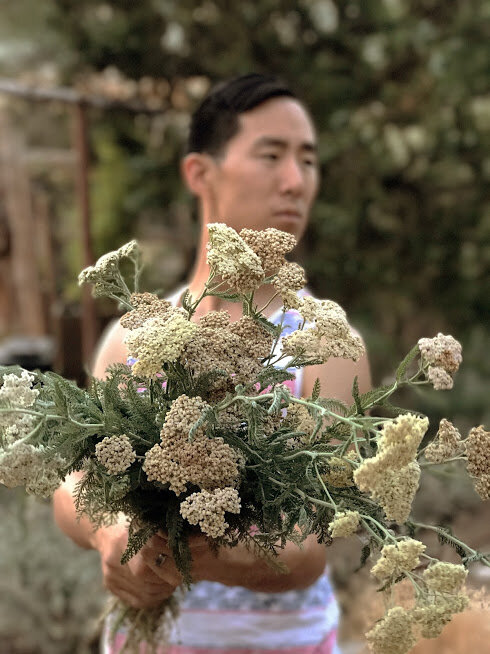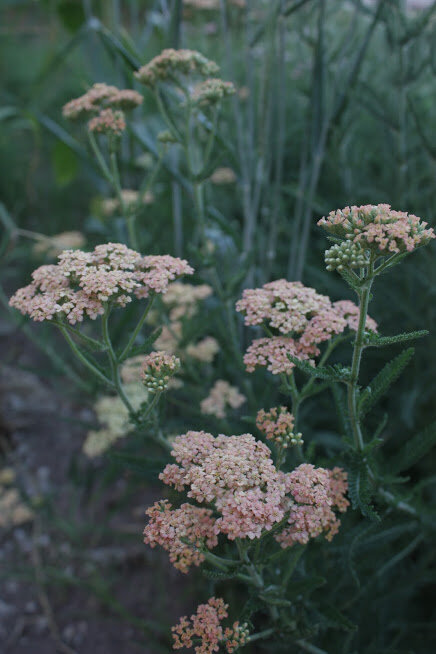How to Grow Yarrow (Achillea) for the Cutting Garden
Yarrow (we call it Achillea because it sounds a bit more lyrical) is a well-known plant that is native to Europe, Asia and North America. It’s typically grown as an herb - known for its medicinal qualities of the stomach - but it is also known for its use as a sturdy ornamental plant in the garden as well.
Yarrow is also a wonderful cut flower - its large broad sprays of small flat-petaled flowers are a wonderful material to use in arranging, combining equally well with soft, fluffy, romantic flowers as well as it does with bolder shapes and textures. It comes in a wide variety of colors - everything from pure white to deep bright red - and comes in those especially coveted soft blush-colored tones.
Easy to grow from seed, tough as nails, drought tolerant and winter hardy as well, yarrow is a great plant to grow - requiring very little care or maintenance - and will provide you with a lot of blooms for use in floral arrangements and bouquets.
One thing to keep in mind is that although yarrow is one of the most reliable and easiest perennials to grow, they usually take at least one full growing season to bloom from seed. The easiest way? Plant them out in late summer to fall, let them overwinter so that you can cut from them the following year.
1. Selecting your Variety
Yarrow comes in a lot of wonderful cultivars that are practically every color of the rainbow. Take for example ‘Paprika’ which is a rusty-orange-red coloration, or “Terracotta” that blooms in deep bronze to light gold hues.
If you’re looking to grow yarrow en masse from seed for use in the cutting garden or as a flower farmer (it’s one of our favorite flowers to grow for designing) then you’ll want to grow “Colorado Mix”. It has a wide variety of colors - the bright and saturated reds, pinks, purples and oranges as well as the light pinks, creams and ivories and light blush and rose pink colors. If you find a plant that you really like as far as color, you can of course then propagate it to create more plants of the same color.
We personally love the wild-type Western yarrow that is native to our area of the country - Achillea millefolium var occidentalis. It blooms in a muted white that is so wonderful for using in wedding work and mixing with lighter pastel colors as well as the occasional light pink sport that is a welcome addition to the white!
2. Starting Yarrow from Seed
Although you’ll want to purchase yarrow plants if you’re wanting specific varieties, you can start both ‘Colorado Mix’ and western yarrow from seed. The seed is small and light, but starts very easily and vigorously.
We start out yarrow in small plug trays - 128 cell trays - so that we have a lot of them to plant out. The seeds will germinate into teeny-tiny little sprouts, but they will eventually start showing off their lacy-edged true leaves that will then grow into plants with the feathery fern-like fronds that yarrow are well-known for. If popped onto a heat mat, they’ll germinate very quickly (within a few days if the seed is fresh).
The seedlings are tough, already demonstrating their drought tolerance and vigor with big fibrous root systems. Just make sure that you don’t keep them too wet - if kept too cold and wet, they may succumb to rot, so keep them well watered but not soggy.
3. Cultivating Yarrow
Yarrow grows pretty easily if given heat and sun and a decent amount of moisture. It takes a while for the little seedlings to get going, but they’ll eventually start putting on some good growth.
We plant our yarrow in an area with fairly good drainage and in full sun, and they seem to do well when planted with other hardy perennials. They may become very vigorous in your environment to the point where they may start crowding out other perennials - so just be careful where you place them.
We’ve had yarrow also die off from overly wet soil during the winter - especially if you live in an area with a lot of late spring moisture when it may still be cold, they may be in danger of rotting from flooding during the spring, so make sure that they’re planted in a higher location so the water drains away from them. Don’t worry if it gets a bit hot and dry in that location - yarrow does well in those conditions.
Again, remember that yarrow is a perennial and requires at least one year to grow enough to bloom. If you can get them established at least by the fall, the yarrow shouldn’t have too many issues overwintering. It will sit as a rosette of green foliage that first year, happily putting out its ferny leaves all season long - but then next spring in about May or June it will start sending up big and thick stalks.
At the top of these stalks are small little clusters that are the immature flower buds - looking almost like a little mini broccoli head - that will then open up into a very large umbel shaped flower head. Broad, flat, with tiny little individual flowers that open together to create the entire head, it’s a wonderful addition to any arrangement.
4. Harvesting Yarrow
Yarrow is best harvested in either the late evening or early morning when the temperatures are coolest.
You’ll need to see if the flower head is mature enough to harvest - usually this is going to be when all the flowers have opened on the entire head, but before it goes brown. This is usually a one week interval for us, giving us a large window of cutting time (again, one of the reasons why we love growing it!)
We also will do a stem check - similar to a zinnia, we’ll grab the stem and give it the “wiggle” test. If the head bends back and forth like a crazy-daisy, it’s too young and needs time to firm up. If the head stays relatively stationary, the stem is firm and ready to harvest.
Cut the stems down at the base of the plant for the longest stem length, ensuring that you strip off the lower leaves. Get them into water and let them hydrate overnight before designing with them.
5. Designing with Yarrow
Using yarrow as a cut flower is easy because of their shape. The large, flat, dome shape really helps to transition between airy filler material (such as ammi and daucus blooms) and focal flowers (like peonies and dahlias) and we use it as a very elegant and hardy filler with its umbellifer shape.
The brighter, more saturated colors such as the bright reds and violets are a wonderful punch of color in arrangements, pairing well with other brightly colored flowers like zinnias, sunflowers and celosia. The deep jewel tones are a wonderful compliment to other colorful flowers, adding rhythm and repetition of color in your arrangement.
The softer, more muted colors such as the blushes and whites are a much different element - appearing much more airy and subtle in their presence, adding an elegant touch to any arrangement they are part of. They are as I mentioned wonderful for wedding work - their beautiful texture and form the perfect addition to centerpieces and bouquets.
Yarrow has a great vase life, lasting well over a week when harvested at the right time. It does not like to be out of water for long periods of time, so make sure that you keep it in water until you’re ready to use it.
Yarrow will also dry well if hung upside down and dried out of light and heat - the strong structure and form is a wonderful addition to wreaths and dried bouquets in the off season.
I hope I’ve inspired you to grow yarrow
It’s such a wonderful plant - low maintenance, drought tolerant, cold hardy, weathering straight through even the hottest and driest summers, pest free, and very vigorous. Just a few plants will offer us buckets of flowers in the summer (and in the fall when it reblooms after being cut back) and those flowers are such a wonderful and elegant touch to any arrangement they are part of.
If you’re interested in growing other hardy perennials, check out some of our growing guides below!
How to Grow Echinacea (Purple Coneflower) for the Cutting Garden
Favorite Herbs to Grow as a Flower Farmer
How to Grow Rudbeckia for Flower Farmers
Growing Hellebores for the Flower Farmer
How to Grow Sedums for the Cutting Garden
How to Grow Eucomis for the Flower Farmer
8 Easy Perennials to Take Cuttings From (And Grow On for Next Year)
Growing Salvias for the Cutting Garden
And if you’re interested in growing cut flowers as a business - whether that’s selling at a roadside stand, a CSA, at a farmer’s market, to florists or for your own design work, check out our eBook bundle for flower farmers!




